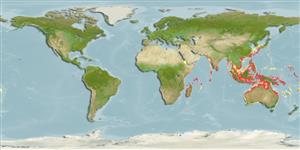>
Eupercaria/misc (Various families in series Eupercaria) >
Labridae (Wrasses) > Bodianinae
Etymology: Choerodon: Greek, choiros = a pig + odous = teeth (Ref. 45335); referrring to the prominent anterior canines of the species in this genus (Ref. 116605).
Eponymy: Dr Johann Lukas Schönlein (1793–1864) was a German naturalist and professor of medicine. [...] (Ref. 128868), visit book page.
More on author: Valenciennes.
Environment: milieu / climate zone / depth range / distribution range
Ecologia
marinhas associadas(os) a recifes; intervalo de profundidade 10 - 60 m (Ref. 9710), usually 10 - 20 m (Ref. 2334). Tropical
Indo-West Pacific: Ryukyu Islands south to Australia and Indonesia. Reported from Mauritius (Ref. 5503).
Length at first maturity / Tamanho / Peso / Idade
Maturity: Lm ?, range 24 - ? cm
Max length : 100.0 cm TL macho/indeterminado; (Ref. 2272); peso máx. Publicado: 15.5 kg (Ref. 2334)
Espinhos dorsais (total) : 13; Raios dorsais moles (total) : 7; Espinhos anais: 3; Raios anais moles: 10. Large adults appear blue underwater and usually have a small black spot at the dorsal fin base. Juveniles have a large white saddle spot following the black spot (Ref. 48636). A moderately small but prominent dark spot present on body at base of last dorsal-fin spine (spot not extending onto fin membrane). Body scales each with a blue centre in life forming horizontal rows of spots on side. Second prominent anterior canine in lower jaw distinctly shorter than first in adults, directed mostly dorsally and slightly anteriorly. 3 to 5 scales on subopercle. (Ref 9823)
Inhabit flat sandy or weedy areas near lagoon and seaward reefs (Ref. 9710). Solitary. Feed mainly on hard-shelled prey including crustaceans, mollusks and sea urchins. Marketed mostly fresh. In Hong Kong live fish markets (Ref. 27253).
Oviparous, distinct pairing during breeding (Ref. 205).
Randall, J.E., G.R. Allen and R.C. Steene, 1990. Fishes of the Great Barrier Reef and Coral Sea. University of Hawaii Press, Honolulu, Hawaii. 506 p. (Ref. 2334)
Categoria na Lista Vermelha da IUCN (Ref. 130435: Version 2024-1)
Ameaça para o homem
Harmless
Utilização humana
Pescarias: espécies comerciais; Aquacultura: espécies comerciais; peixe desportivo: sim; Aquário: Espécies comerciais
Ferramentas
Relatórios especiais
Descarregue XML
Fontes da internet
Estimates based on models
Preferred temperature (Ref.
123201): 24.5 - 29, mean 27.9 °C (based on 478 cells).
Phylogenetic diversity index (Ref.
82804): PD
50 = 0.5000 [Uniqueness, from 0.5 = low to 2.0 = high].
Bayesian length-weight: a=0.01288 (0.00577 - 0.02877), b=3.05 (2.85 - 3.25), in cm total length, based on LWR estimates for this (Sub)family-body shape (Ref.
93245).
Nível Trófico (Ref.
69278): 3.4 ±0.41 se; based on food items.
Generation time: 4.2 ( na - na) years. Estimated as median ln(3)/K based on 1
growth studies.
Resiliência (Ref.
120179): Médio, tempo mínimo de duplicação da população 1,4 - 4,4 anos (Preliminary K or Fecundity.).
Fishing Vulnerability (Ref.
59153): Moderate vulnerability (39 of 100).
Nutrients (Ref.
124155): Calcium = 29.2 [17.1, 44.4] mg/100g; Iron = 0.517 [0.303, 0.893] mg/100g; Protein = 18.9 [16.0, 21.0] %; Omega3 = 0.123 [0.083, 0.189] g/100g; Selenium = 44.2 [27.5, 74.7] μg/100g; VitaminA = 46.1 [15.6, 155.2] μg/100g; Zinc = 0.975 [0.721, 1.477] mg/100g (wet weight);
